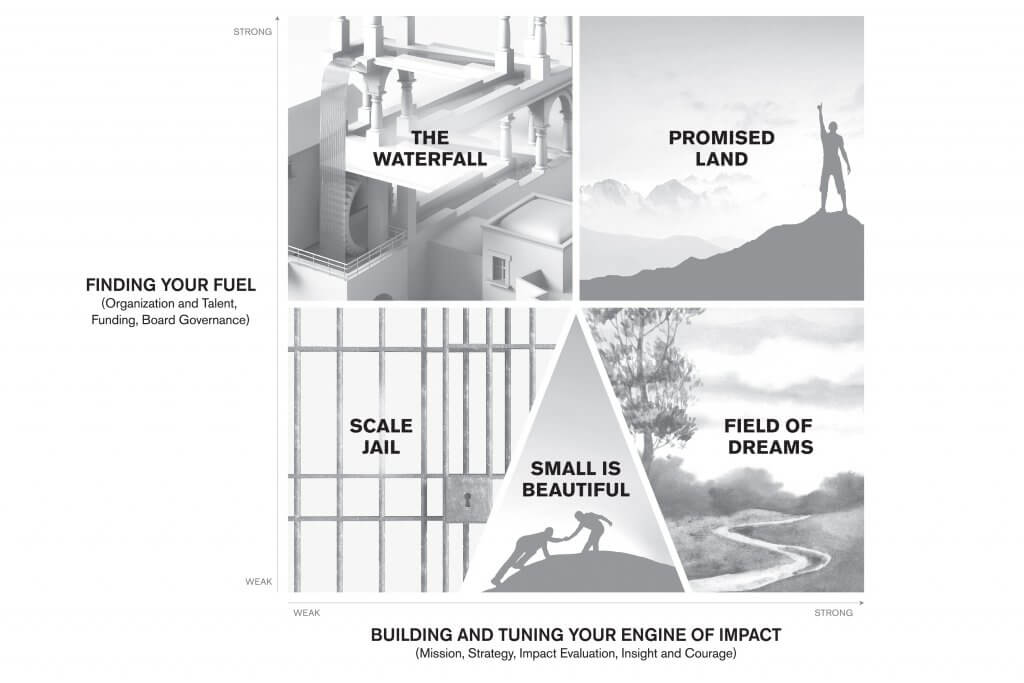Your Engine of Impact: Scaling
The mission of a nonprofit organization is its raison d’etre and its guiding light: A nonprofit exists to fulfill its mission—and its mission, as encapsulated in its mission statement, will ideally ensure that it stays on course. Yet, despite the paramount importance of having a clear and focused mission and mission statement, most nonprofits fall short in this area.
This unfortunate truth is brought home, year in and year out, in a class called “Strategic Management for Nonprofits” that one of us—Bill Meehan—teaches at the Stanford Graduate School of Business. The very first assignment Bill gives students is to pick a nonprofit and evaluate the effectiveness of its mission statement. Next, the students contact the organization and interview half a dozen stakeholders about the mission—how well is it known, understood, and applied? Across nearly two decades and among roughly a thousand students, the results have been discouragingly similar: about three-quarters of the students determine that the mission statement they have evaluated is unfocused, overly broad, and therefore limited in its effectiveness as a guide to the many choices that the nonprofit must make.
The same unfortunate truth was borne out in the work that one of us—Kim Jonker—undertook while running the Henry R. Kravis Prize in Nonprofit Leadership. Indeed, many of the nonprofit leaders with whom she worked stressed the danger of “mission creep,” a condition in which organizations with overly vague or broad mission statements lose their capacity to just say, “No, thank you,” to offers of funding or to opportunities that fall outside their mission scope.
Mission is one component of the engine of impact that every nonprofit organization must build and tune in order to become truly effective. Nonprofit leaders who want their organization to achieve maximum impact, we believe, must embrace the essentials of strategic leadership. We compare this kind of intentional leadership to a high-performance engine. Mission—the first essential part of this engine—helps to inspire key stakeholders and to guide an organization in making key decisions.
Almost every nonprofit would benefit from a periodic review and reassessment of its mission and mission statement, perhaps as part of a strategic planning effort. A nonprofit mission, we believe, must possess seven essential qualities. Here are three of these qualities. (We explore all seven qualities in our book, Engine of Impact.)
It must be focused
The world is full of worthy causes and holds untold numbers of people who truly need help—but no impactful nonprofit can be all things to all people. An organization whose mission is to “end global poverty,” “establish world peace,” or carry out some equally worthy, but essentially impossible, task is an organization without a clear focus and, in all likelihood, lacks a clear understanding of its core competencies. Focus invariably beats diversification: to have maximum impact, focus your mission.
It must solve unmet public needs
Nonprofits exist to address needs that are not sufficiently tackled by markets and governments. A nonprofit’s mission should thus be to meet some public need that businesses, governments, and other organizations have failed to properly address.
It must guide trade-offs
A nonprofit’s mission should help its leaders decide which initiatives to pursue and which to avoid. Funding opportunities or programs that are compelling but not aligned with the mission should not be undertaken. On the other hand, initiatives that will clearly further the mission should be accepted, even if doing so will challenge the organization.
Landesa offers an excellent example of a nonprofit whose mission embodies these qualities. This mission, as encapsulated in the Landesa mission statement, is focused: “Landesa champions and works to secure land rights for millions of the world’s poorest, mostly rural, women and men to provide opportunity and promote social justice.” It solves an unmet need—helping to give land to landless people who need it to survive. And it has proven to be a powerful tool for guiding the organization’s trade-offs.
Back in 1998, for instance, Landesa had an opportunity to undertake an urban land rights program in the former Soviet Union. The need was compelling, but Landesa’s clearly stated mission was to help “mostly rural” poor. So its leaders said, “No, thank you.” The following year, they found themselves debating the merits of expanding into India. Once again, the need was clear, but some members of the leadership team were wary of the many challenges such expansion would entail, among them political and financial risks. In the end, however, they looked to their mission, considered the vast numbers of rural poor in India who could benefit from Landesa’s help, and decided to take the plunge.
An effective nonprofit must have a clear and focused mission statement that all stakeholders of the organization are able to live and breathe. The evaluation of every opportunity or new program area should begin, and end, with a consideration of its mission—the be-all and end-all for nonprofits.
Originally published by Guidestar


